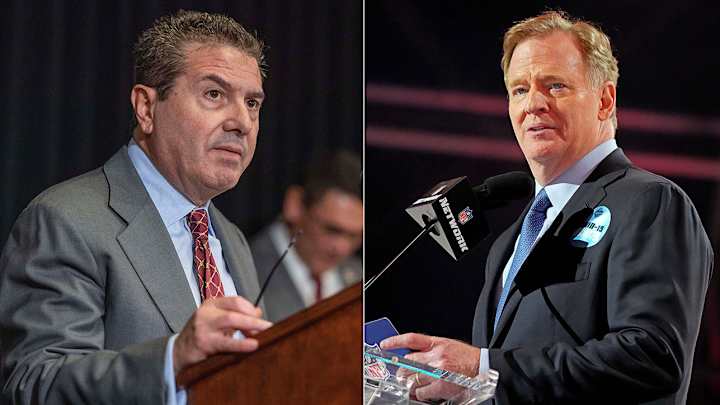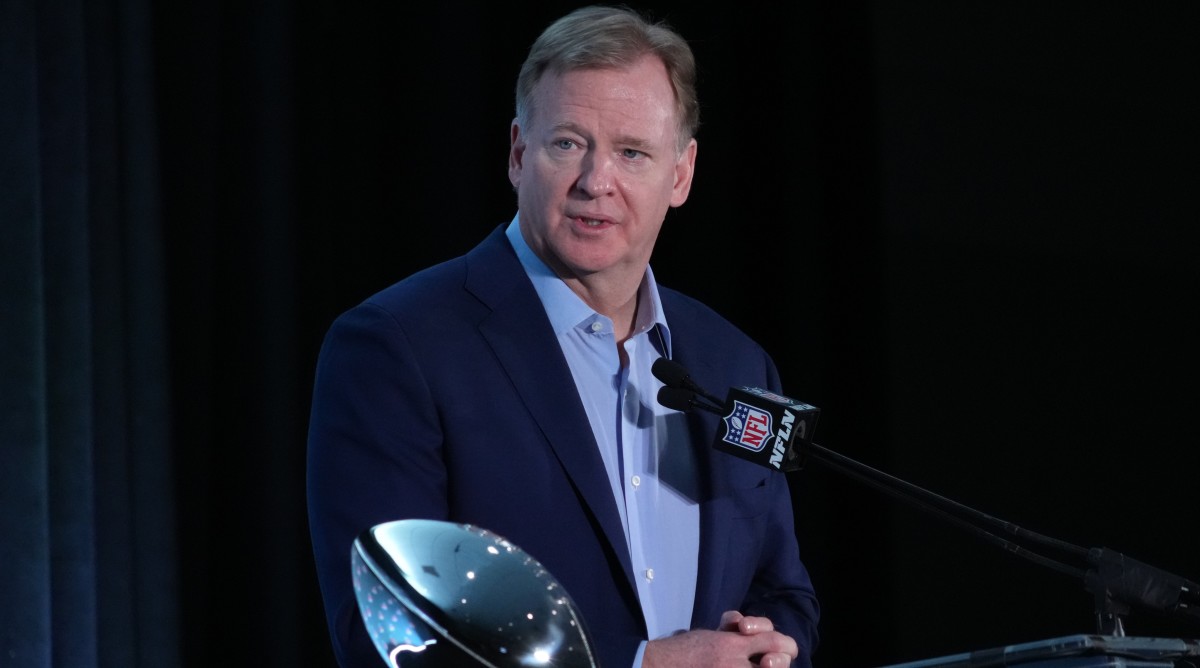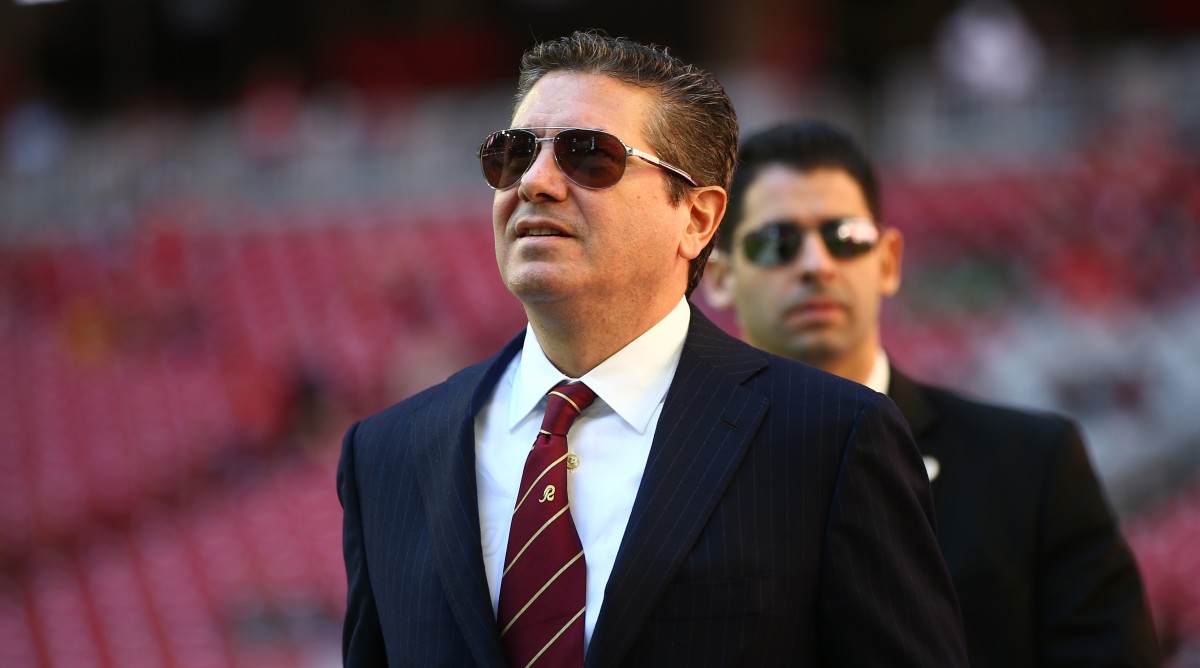How Roger Goodell Persuaded NFL Owners to Change the Kickoff Rule

June’s here, mandatory minicamps start next week and we’re rounding the turn toward the NFL’s summer break. My takeaways for the week …
The change in the kickoff rule happened in a way it shouldn’t have. The standard for any rules change in the NFL is a 24–8 vote, and there’s a reason why it’s not a simple majority—it isn’t, and shouldn’t be, easy to rewrite the rule book. And, yet, here we are, and over a two-month period through which a grand total of zero games were played, the league moved from being split on the NFL’s proposed kickoff modification to strongly supporting it.
At the March owners meeting, commissioner Roger Goodell could barely get the room to 16–16 and the competition committee’s idea to allow for fair catches inside the 25-yard line to be counted as touchbacks, with the ball coming out to the 25. At the spring meetings May 22–23 in Eagan, Minn., after Goodell politicked for those two months—by show of hands—there were around 13 no votes on the floor, leaving the NFL, counting the Raiders’ abstention, well short of the 24 needed to pass the change.
“We’ll pick this up in the privileged session,” Goodell told the room, after it became clear he didn’t have the votes on the first day of the league’s spring meeting.

And in that owners-only privileged session, like magic, the proposal was voted through.
The final count was 26-5-1—the Ravens, Patriots, Bengals, Bears and Lions voted against it—which means that, in less than 24 hours, Goodell was able to flip eight teams. That’s a quarter of the league swayed by the commissioner and his team of lieutenants (Rich McKay, Dawn Aponte, Jeff Miller and Dr. John York were among those selling) overnight.
Again, the idea here is that it’s supposed to be difficult to change rules.
We can go over why the NFL’s 32 special teams coaches and 34 special teams players, representing all 32 teams, got on calls two weeks ago and unanimously agreed that the new kickoff rule wouldn’t fix anything—and might in fact make the play more dangerous. We can show you why John Harbaugh, Sean Payton, Bill Belichick and Dan Campbell backed those coaches and players, and why the threat of litigation, used by Goodell and his team to wrangle votes for the proposal, shouldn’t be enough to swing the pendulum.
But we’ve explained all that already. To me, the overriding issue here is how it happened. How the NFL ignored the people who know the play that’s changing best, and understand the reaction that’ll come to the action (with squibs, knucklers, directional kicks, etc.). How this became about getting owners away from their coaches and players, and having the last word with them. How an NFL that’s planning for its stars to play more games this year on Thursday and on turf than ever before is using this to try to occupy the high ground on safety.
And, truthfully, the whole thing sucks.
On the flip side, from the league’s spring meetings, the accelerator program did bring more positive results for the participants. Last week’s session was the first to focus on coaches—last May’s was for scouts and coaches, while December’s was just for the personnel folks—and there was a pretty good variety in age and background among the 40 participants.
Titans quarterbacks coach and passing game coordinator Charles London returned after taking part in last year’s program. At that point, he was still with the Falcons, and through that experience came this year’s plan.
“My plan was, after the first year, to build on some of the relationships that I started with some of the different owners,” London told me over the weekend. “I got to spend some time last year with Bryan Glazer of the Buccaneers, and it kind of worked out again where we were at the same breakfast table. So to continue to build on that relationship, and the talks we had last year were good. But, also, I had targeted certain people that I had admired from afar or that I wanted to get to know from an ownership or a team president level.”
The goal was the same for 64-year-old, former Bills defensive coordinator Leslie Frazier, who came in with the perspective of having taken part in symposiums for rising assistant coaches some two decades ago. And, to Frazier, the ability to accomplish that goal marked the difference in this event from the ones he’d done in the past.
“[The old format] wasn’t as strategic as far as getting in front of the owners as this event was,” Frazier says. “It was designed to introduce you to the way the league operates, the salary cap, prepare you for interviews, it was just framed a little bit different. … The one night when they had a cocktail gathering, where we were over at the Vikings’ Hall of Fame, and just organically going around and saying hello to different owners, that was really a good environment to say hello and let your hair down and just talk.”
Frazier did concede that much of the classroom work done during the accelerator was old hat for him, and that makes sense—he was a head coach already both in college and the pros, and played five years, and coached the last 24, in the NFL. But he took plenty from a couple of the speakers.
One was his old colleague from Philadelphia, Don Smolenski, who is now the Eagles’ team president, and gave the participants an overview of how a team handles its finances and manages a budget. Another that seemed to impress everyone, including Frazier and London, was former McDonald’s CEO Don Thompson, who gave a presentation on leading an organization and all that goes into it.
“The biggest things I got out of it—leadership, dealing with people, having a vision, having a plan and building a positive culture within a building,” London says. “He’s talking about it from a CEO perspective, but that’s no different than what a head coach does. You gotta come in, set the tempo, rally the troops, build a culture. So it was just good to hear him talk about it from a business perspective. And I looked at it like, Hey, that’s what a head coach does when he gets a new job and tries to come in and set the tempo, set the culture for his new team.
“It’s the same thing you’d do at a Fortune 500 company.”
So, yes, there were a lot of good vibes to come out of the programs last week. And we’ll see in January or so how much progress has been made.
Frazier’s in an interesting place right now. He decided to take this year off after serving as Sean McDermott’s defensive coordinator for the past six years in Buffalo and, as you’d think, as he settled into spending more time at his offseason home in California, it wasn’t the most comfortable thing at first.
Frazier has spent his past 35 years, more than half of his life, coaching football.
“Man, early on, this is the third month. So for me, that first month or two, it was hard, man, just trying to find my rhythm and getting used to having free time,” Frazier says. “It’s been so long, more than 30 years, since I haven’t been on a schedule this time of the year. So it was a challenge just trying to figure out what to do with myself. But over the last three or four weeks, things have gotten a lot better as far as me being organized in how I want to spend my time. And I’m thankful for it, just very, very thankful that I can do this.
“I’m so grateful that I’m in a position where we can step back and not be sweating about finances. So, just very thankful.”
He’ll start to put the free time to use this week in heading out to visit old coaching friends, with his focus on using that experience, and experiences like the accelerator, to get in the mix for jobs in January.
Maybe it happens for him. Maybe it doesn’t. Either way, he’s at peace with where he’s at.
“I really feel good about where I am,” he says. “I think my reasons for stepping away were the right reasons; I feel good about it. It just gives me a chance to see things from a different perspective, get recharged again and reenergized. I’m gonna go watch some teams in their OTAs, will probably do the same thing again in training camp, go visit some clubs as well. And then in the fall, I will really begin to take a look at what’s happening around the league, make sure I stay up on any new trends, anything that’s changing.
“And, hopefully, an owner will give me a chance to talk to him about an opportunity. If that doesn’t happen, I’m good. I’ve had a good career. I’m good. My goal is to be a head coach. I know I don’t have much time left, I’m at an age [64] where it seems like owners are going younger and younger, but I think I have some things I can bring to the table. We’ll see what happens.”

There’s really no reason to panic—if you’re a Washington fan. No, the Commanders sale didn’t happen this month. Yes, the terms are still at issue, and there’s plenty for the league and its finance committee to work through with Josh Harris’s group.
But everyone wants this sale to happen. Other owners want Harris in their club. They also want Daniel Snyder out of it. And going back to square one isn’t an option here.
The larger question, to me, would be whether the NFL uses this situation to take a broader look at its ownership requirements, which call for the primary owner in any purchasing group to have 30% of the total price paid in cash. That rule was more practical a few years ago, when David Tepper bought the Panthers for $2.275 billion (or last year, when the Waltons purchased the Broncos). Going forward, with a price point past $6 billion for the Commanders, it’s going to be harder and harder to find prospective buyers capable of meeting that requirement.
That said, both the owners who spoke on the record, and those I talked to off the record, last week seemed to have no appetite for changing the rule. And when I asked Dallas’s Jerry Jones flat-out if he’s confident Harris will wind up getting there, he bluntly said, “I am.”
So I think that discussion gets tabled until the next time around. Or, if Seattle’s the next team sold, the time after that (if Steve Ballmer or Jeff Bezos wind up buying the Seahawks, they might not have to change the rules). And I’d bet Harris, as Jones predicts, does wind up coming up with the cash, with his group approved at a special league meeting at some airport hotel in Chicago or Dallas in late July or early August.
The Patriots’ latest rules-breaking fiasco isn’t much of a fiasco at all. This one’s pretty straightforward. NFL rules state that during Phase II of the offseason program, teams can only schedule out four hours of voluntary work on any day for players (limited to four days per week). So in April, the Patriots distributed a four-hour schedule for Phase II that started for offensive players at 7:30 a.m. and for defensive players at 9 a.m.
At the team facility, on a corkboard outside the locker room, there was a notice for special teams workshops that kicked off at 7:10 a.m. for offensive players and 8:40 a.m. for defensive players—workshops that weren’t part of the aforementioned four-hour schedules. They were relaxed and informal, and also outside of what was allowed.
Now, had Patriots assistant Joe Judge, named in the report, simply met with guys in passing over breakfast (which is how the meetings were structured) that probably would’ve been fine. In fact, that’s the way things have to happen in Phase II for special teams coaches in a lot of cases, since head coaches won’t give up minutes within those four hours (during which strength and conditioning, meetings and on-field work takes place) for the third phase of the game, preferring to use players’ football-specific time on offense and defense.
So the special teams coach often works around it, and the Patriots did. Posting the existence of those meetings was the first mistake. Not stopping them after being flagged was the second mistake, putting New England back in a penalty box they’re familiar with.
Obviously, after the year the Patriots’ coaching staff had last year, and given the team’s history with this stuff, it is a pretty tough look for everyone involved. Even if, again, it really isn’t that big of a deal overall.
Monday was Memorial Day, and, as such, I wanted to make sure we had a special thanks in here to finish up to all our servicemen and servicewomen. Over the past few years, I’ve learned what Memorial Day is like for them, and how difficult a holiday it can be for any of them. So, last year, I had Nate Boyer—the Green Beret who did multiple tours in Iraq and Afghanistan, who became a long snapper at Texas and got to training camp with the Seahawks—try to put it into words for our readers.
It was really good. So I’m gonna give it to all of you again.
“Memorial Day can be a really hard day for a lot of people, a lot of veterans, a lot of family members and friends. But at the same time, I think it’s important for veterans to try and shift the focus to it being a day of celebrating these people. For any of us who served and lost buddies, we know that those guys wouldn’t want us only feeling guilty or bad about ourselves today. Survivor’s guilt is very real, but it’s maybe the last thing those no longer with us would want us to feel.
“So really think about them and think about what they’d want us to do today, and every day for that matter. I’d imagine most of them would want us to celebrate the life they lived. Honor them, remember them, but have a good time with those that are still here. I think that’s the best way for us to move forward, with the way that we live our lives onward. And for a lot of the civilian community that don’t feel a direct connection to today, it’s never offensive to thank somebody for their service, but it’s important to understand the difference between Veterans’ Day and Memorial Day.
“This is the day we honor those that paid the ultimate sacrifice. So there’s no need to thank us. Maybe spend time with us, check on us, let us know that you support us, but also recognize that today might be a tough day for us. This is the one day that we all set aside to remember our brothers and sisters in arms that didn’t make it back, the ones that laid it all down for us so that we can live freely and enjoy days like today, enjoy the freedoms that we have here in this country.
“Yes, living with survivor’s guilt can be challenging, but we also have a survivor’s responsibility to the people we recognize as heroes. Because to me, and many of the warfighters I fought alongside, heroes don’t walk the earth …”
Thanks to Boyer for helping educate me on the day that, for most of us, is the unofficial kickoff to summer and, again, to everyone who has served or is serving now.
